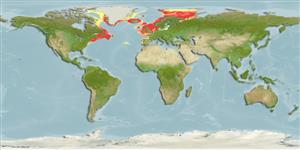Environment: milieu / climate zone / depth range / distribution range
Ecologia
marinhas demersal; oceanódromo (Ref. 51243); intervalo de profundidade 1 - 600 m (Ref. 58426), usually 18 - 110 m (Ref. 7135). Temperate; 82°N - 40°N, 75°W - 61°E (Ref. 119696)
Northeast Atlantic: Spitsbergen southward to White Sea, Scandinavian coasts, North Sea, the British Isles, to the Northen part of Bay of Biscaye, also Iceland and south-eastern coasts of Greenland (Ref.. 57932). Northwest Atlantic: southern Labrador in Canada and western Greenland to Cape Cod in Massachusetts, USA; rarely to New Jersey, USA (Ref. 7251). Elsewhere in the Baltic Sea and Mediterranean from Ref. 57932 should be regarded as questionable, as stray at most, until original reports are cheked (see Ref. 119696).
Comprimento de primeira maturação / Tamanho / Peso / Idade
Maturity: Lm 55.0, range 50 - 60 cm
Max length : 150 cm TL macho/indeterminado; (Ref. 7251); peso máx. publicado: 23.6 kg (Ref. 40637)
Ground color usually greyish-green but almost black or reddish -brown. Body with 10-15 transverse, dark bars extended to the dorsal fin (Ref. 35388).
Inhabit rocky bottoms, sometimes over sand or mud, from 1-500 m (Ref. 9988). Benthic (Ref. 58426). Feeds on fishes (Ref. 58426), hard-shelled mollusks, crabs, lobsters, sea urchins and other echinoderms. Solitary in habit (Ref. 9988). Marketed fresh and frozen; eaten steamed, fried, broiled, boiled, microwaved and baked (Ref. 9988).
Males guard a clutch of eggs right up to the time of hatching (Ref. 6407). During brood protection, the male hardly feeds (Ref. 6407).
Barsukov, V.V., 1986. Anarhichadidae. p. 1113-1116. In P.J.P. Whitehead, M.-L. Bauchot, J.-C. Hureau, J. Nielsen and E. Tortonese (eds.) Fishes of the North-eastern Atlantic and the Mediterranean. volume 3. UNESCO, Paris. (Ref. 4694)
Status na Lista Vermelha da UICN (Ref. 130435: Version 2024-2)
Ameaça para os humanos
Harmless
Uso pelos humanos
Pescarias: altamente comercial; Aquacultura: experimental; peixe esportivo: sim; Aquário: Aquários públicos
Ferramentas
Relatórios especiais
Baixar XML
Fontes da internet
Estimates based on models
Preferred temperature (Ref.
123201): 0.8 - 12.1, mean 7.8 °C (based on 1910 cells).
Índice de diversidade filogenética (Ref.
82804): PD
50 = 0.5938 [Uniqueness, from 0.5 = low to 2.0 = high].
Bayesian length-weight: a=0.00407 (0.00305 - 0.00544), b=3.19 (3.11 - 3.27), in cm total length, based on LWR estimates for this species (Ref.
93245).
Nível Trófico (Ref.
69278): 3.6 ±0.0 se; based on diet studies.
Resiliência (Ref.
120179): Baixo, tempo mínimo de duplicação da população 4,5 - 14 anos (K=0.04-0.1; tm=6-7; Fec=12,740-25,000).
Prior r = 0.40, 95% CL = 0.26 - 0.60, Based on 3 full stock assessments.
Fishing Vulnerability (Ref.
59153): High to very high vulnerability (69 of 100).
Climate Vulnerability (Ref.
125649): Moderate vulnerability (38 of 100).
Nutrients (Ref.
124155): Calcium = 8.54 [4.15, 34.43] mg/100g; Iron = 0.178 [0.082, 0.506] mg/100g; Protein = 17.1 [15.1, 19.7] %; Omega3 = 0.376 [0.216, 0.633] g/100g; Selenium = 38.1 [13.6, 104.4] μg/100g; VitaminA = 6.68 [2.05, 21.68] μg/100g; Zinc = 0.675 [0.265, 1.313] mg/100g (wet weight); based on
nutrient studies.
